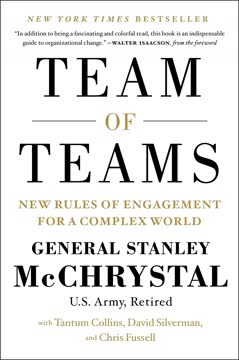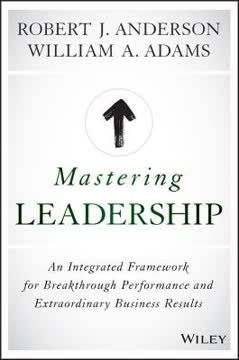Key Takeaways
1. Leadership at Scale: The Imperative for Organizational Growth
"Leadership scales capacity and capability in others, through teams, and in the organization."
Leadership as a multiplier. Effective leadership is not just about individual performance, but about cultivating capacity and capability throughout the organization. This scaling effect is crucial for sustained growth and adaptability in today's rapidly changing business environment.
Conditions for scale. To achieve leadership at scale, leaders must create specific conditions:
- Creative leadership
- Deep relationships
- Radically human approach
- Systems awareness
- Purposeful achievement
- Generative tension
These conditions work together to create an environment where leadership can flourish at all levels, enabling the organization to respond effectively to complex challenges and opportunities.
2. The Development Gap: Navigating VUCA Environments
"We are required to operate with incomplete information in unpredictable environments."
VUCA world demands. Today's business environment is characterized by Volatility, Uncertainty, Complexity, and Ambiguity (VUCA). This reality places unprecedented demands on leaders, requiring them to develop new capabilities and mindsets to navigate effectively.
Bridging the gap. The development gap refers to the disparity between the complexity of the challenges leaders face and their current capacity to address them. To bridge this gap, leaders must:
- Continuously evolve their skills and mindsets
- Embrace ongoing learning and development
- Cultivate adaptability and resilience
- Develop systems thinking to understand complex interdependencies
- Foster collective intelligence within their teams and organizations
3. Creative vs. Reactive Leadership: Contrasting Approaches
"High-Creative leaders get a multiple on their leadership by optimizing the focus on results with developing their people."
Creative leadership traits. Creative leaders exhibit several key characteristics:
- Strong people skills
- Visionary thinking
- Team-building abilities
- Approachability
- Leading by example
- Passion and drive
- Effective listening
- Developing others
- Empowering people
- Positive attitude
Reactive leadership limitations. In contrast, reactive leaders often rely on:
- Technical expertise
- Domain knowledge
- Individual drive
- Self-centric motivation
While these traits can lead to short-term success, they often limit long-term effectiveness and organizational scalability.
4. The Canceling Effect: How Leaders Undermine Their Effectiveness
"High-Reactive leaders have a Leadership Ratio of 0.9 to 1. This means you are in your own way."
Self-defeating behaviors. The Canceling Effect occurs when leaders' strengths are offset by corresponding liabilities. Common examples include:
- Drive and passion canceled by ineffective interaction styles
- Visionary thinking undermined by poor teamwork
- Strong networking abilities negated by underdeveloped teams
- Technical knowledge offset by over-demanding behavior
Leadership Ratio. This concept measures the balance between a leader's strengths and liabilities. A ratio below 1 indicates that liabilities outweigh strengths, effectively canceling out leadership effectiveness and limiting organizational growth.
5. Scaling Leadership: A Three-Step Approach
"Your most important job as a leader—Job 1—is to develop other leaders."
Step 1: Start with yourself.
- Gain self-awareness through feedback and reflection
- Identify your "One Big Thing" for development
- Seek support and be open to change
Step 2: Develop leadership teams.
- Treat your team as a team of leaders
- Assess individual and collective effectiveness
- Ensure the right people are in place
- Build alignment around shared purpose and vision
Step 3: Build leadership systems.
- Create a developmental organization
- Implement systems to measure results
- Institutionalize the development agenda throughout the organization
6. The Universal Model of Leadership: Stages of Development
"Your level of leadership is related to your level of adult development."
Developmental stages. The Universal Model of Leadership identifies three progressive stages of adult development:
- Socialized Mind (Reactive Leadership)
- Self-Authoring Mind (Creative Leadership)
- Self-Transforming Mind (Integral Leadership)
Impact on leadership. As leaders progress through these stages, they become:
- More effective in navigating complexity
- Better able to balance competing demands
- More skilled at fostering collective intelligence
- More capable of leading systemic transformation
7. Transforming Reactive into Creative Leadership
"The shift from Reactive to Creative leadership is nothing short of a transformation—a fundamental shift of mind and heart."
Three key movements:
- From authored by others to authored by self
- From safety to purpose
- From ambition to service
Unlocking potential. This transformation allows leaders to:
- Access a fuller range of leadership competencies
- Develop complementary skills
- Lead with greater authenticity and effectiveness
- Foster a more engaged and empowered organizational culture
8. Practices for Leadership Transformation
"Generative tension is established by cultivating a gap between what we want and what we've got."
Key practices for transformation:
- Establish generative tension
- Tell the truth about what you want (vision and purpose)
- Tell the truth about current reality
- Be intentional in your leadership
- Practice daily reflection and feedback
- Develop intuition
- Lead change publicly and vulnerably
Systemic approach. Effective leadership development requires:
- Long-term commitment
- Integration of individual and organizational development
- Creating a feedback-rich environment
- Institutionalizing ongoing learning and growth
By embracing these practices, leaders can continuously evolve their capabilities, scale their impact, and create more adaptive and thriving organizations.
Last updated:
Review Summary
Scaling Leadership receives mostly positive reviews, with readers appreciating its insights on creative leadership and personal growth. Some praise the concepts of generative tension and self-authorship, while others find value in the leadership assessment tools. Critics note the book's verbose style and heavy reliance on survey data. Many readers consider it a valuable resource for leadership development, despite occasional challenges in digesting the content. The book emphasizes the importance of continuous self-improvement and adapting to complex business environments.
Similar Books










Download PDF
Download EPUB
.epub digital book format is ideal for reading ebooks on phones, tablets, and e-readers.





